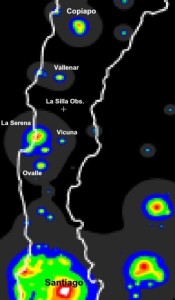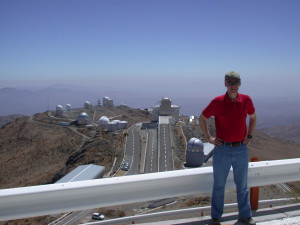The HAC website now has a new area under ‘Resources‘ where we will be adding content regarding all manner of light pollution issues. Bob Gent has already penned a great article drawing on his prior experience as a past president of the International Dark-Sky Association. Please give it a read and pass the link along to your friends and neighbors. We welcome all contributions to our Resources page, no matter which astronomy topic you wish to address.
Category Archives: Light Pollution
Articles addressing the problem of light pollution.
Protecting Our Night Skies from Light Pollution
There are about 60 members of the Cochise County Association of Astronomical Observatories. In addition, many HAC members moved here because of the excellent night skies. We moved to this area and built homes and astronomical observatories. But many people who are not astronomers enjoying looking at our magnificent night sky. While many astronomers care deeply about preservation of our night skies, the issue of light pollution reaches far beyond that.
Light pollution is caused by aiming lights into the sky, blinding people with glare, or by leaving lights on when and where they are not needed. When we allow bad lighting at night, we waste an enormous amount of energy and endanger our own health and safety as well as that of many animals. Fortunately, good lighting is easy, and our area has excellent outdoor lighting codes to help us do the right thing.
If you have county neighbor with a really obtrusive and invasive light, Have them check our the Cochise County Light Pollution Code. It was recently updated and can point the person in the right direction. There is also a link to file code violations in the county. For more information, see this link:
https://cochisecounty.municipalcodeonline.com/book?type=ordinances#name=2.45_LIGHT_POLLUTION
If you live within the City of Sierra Vista, the outdoor lighting code was updated in 2015. See sections 151.11 to see our city’s outdoor lighting code:
https://codelibrary.amlegal.com/codes/sierravista/latest/sierravista_az/0-0-0-19938
and section 151.10 for sign regulations:
https://codelibrary.amlegal.com/codes/sierravista/latest/sierravista_az/0-0-0-19777
If you need more help with light pollution, be sure to visit the website of the International Dark-Sky Association. Or even better, join the IDA. They lead the charge in protecting the nighttime environment. They have published dozens of IDA Practical Guides to help us. For more information, see: www.darksky.org
Crime
Many of us are afraid for the dark, and bright lights at night can give us a false sense of security. What we need is better situational awareness coupled with better light designs. Most crime actually occurs during the day, and at night, lighting by itself does not insure safety. A recent US Department of Justice report to Congress concluded, “We can have little confidence that lighting prevents crime, particularly since we do not know if offenders use lighting to their advantage…. In short, the effectiveness of lighting is unknown.” When we fear the night, do bright lights really make s safer. Do criminals need light to see to commit crime? Could they too be afraid of the dark?
Safety
Bright lights cause glare that decreases visibility. When lights shine in our eyes we can’t see much except the light source. We can’t see the steps or handrails to a doorway. We can’t see the bad guy behind the light. And you know what it’s like to have drivers shine their high beams into your eyes. It takes a while to recover your night vision.
Human Health
For millions of years, life on earth evolved with a day and night. Now, we are turning the night into day with unintended consequences. Ongoing research indicates there may be serious impacts on human health from overly bright lights. When we sleep with lights around us or invading our bedroom window, we suffer something called melatonin suppression. This adversely affects our circadian rhythm – our sleep pattern – as well as our immune system. Medical doctors are also studying the link between cancer and melatonin suppression from lights at night.
Wild Life
Light pollution also adversely impacts many forms of nocturnal wildlife. Florida’s sea turtles have been facing a major threat from bright lights. Endangered sea turtles emerge from the surf to deposit eggs in sand nests and later, tiny hatchlings struggle from their nests to return to the ocean. The turtles instinctively look for moon light reflecting off the ocean to guide them to the water, but mistake manmade lights for moon light and die. Similarly, many species of birds, especially small insect-eaters, migrate at night. Guided in part by the starlight of constellations, they are attracted to lights shining from skyscrapers, broadcast towers, lighthouses, monuments and other tall structures. Some birds either flutter about until they drop from exhaustion, or actually hit the object and die.
Property Rights
Light trespass is another serious problem. Light at night can be as offensive as neighbors driving across your yard or parking on your property. When a person aims bright floodlights at their neighbor’s yard, they invade their property and destroy a good night’s sleep as well as their ability to see the sky.
Monetary Investments
In Cochise County, astronomy is a major investment. By our estimate, there are over 50 astronomical observatories here. In addition, there are hundreds of millions of dollars in professional astronomical observatories near Cochise County. Even though we have good lighting codes in place, there are still adverse impacts on both professional and amateur research. We need everyone’s help to protect this research. Your local astronomers may be the ones to spot an asteroid headed for Earth!
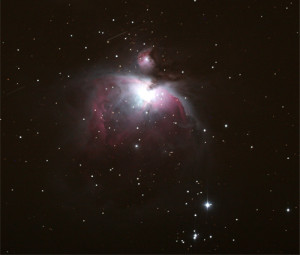 |
| Here’s a photo of the Great Orion Nebula taken a few days ago by the author. Photos like these are possible only from protected areas, like Cochise County. |
Good Lighting is Easy
Our current city and county lighting codes are designed to help achieve the goals of good lighting. But in a nutshell, the key to high quality nighttime lighting is to follow a few simple rules. First, insure that glare is minimized. Most glare comes from unshielded fixtures and bad lighting design. You should never see a light bulb. Shine the light down and only when and where it is truly needed. Don’t light up trees or walls. Next, use time controls to insure that light is on when needed, and off when it is not. Lights should only be on when there is a person in the area. Motion activated lights are available, too. As an added bonus, your pocket book will benefit if you use only energy efficient light sources.
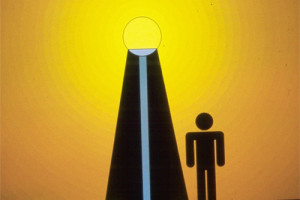 |
| Here’s an illustration showing light going everywhere except where it’s needed |
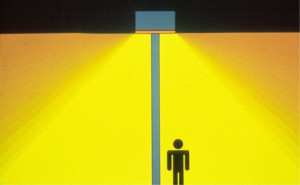 |
| A better way to light is to aim light down, and only when it’s needed. Images courtesy International Dark-Sky Association, Inc. |
Preserving Our Heritage
Light in the sky is called sky glow. It’s a bright nighttime dome over most cities. It destroys our view of the universe. Go outside on a cloudless night. Here you can still see the color, shape and density of our own galaxy, the Milky Way. This is a privilege very few Americans have. It is priceless. All across the country and around the world, people are losing touch with the night. This means our children and generations to come are in danger of losing their God given right to experience the grandeur of the universe. That would be a tragedy! Let’s not let that happen in Cochise County or Sierra Vista.
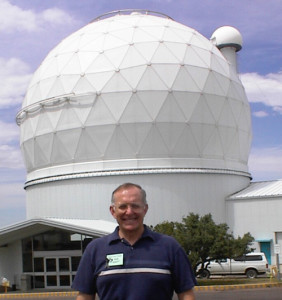 About the author: Lt Col Bob Gent is a retired USAF Space Systems Officer, and he is the past president of the Astronomical League, an educational federation of 300 astronomical societies and 15,000 members. He is also the past president of the board of the International Dark-Sky Association. IDA has thousands of members from over 70 countries. He and his wife Terrie built and operate the Cochise Skies (Astronomical) Observatory in Mountain Shadows in Sierra Vista, Arizona.
About the author: Lt Col Bob Gent is a retired USAF Space Systems Officer, and he is the past president of the Astronomical League, an educational federation of 300 astronomical societies and 15,000 members. He is also the past president of the board of the International Dark-Sky Association. IDA has thousands of members from over 70 countries. He and his wife Terrie built and operate the Cochise Skies (Astronomical) Observatory in Mountain Shadows in Sierra Vista, Arizona.
Photo at left is Bob visiting the McDonald Observatory in Texas.
The Quest For Darker Skies
Biography
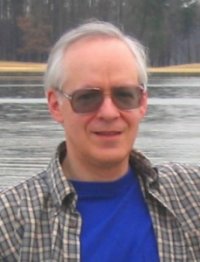 David Butler and his wife Gloria recently moved to Sierra Vista from North Carolina, where he was an active member of the Charlotte astronomy club. David studied Business at the University of North Carolina and later received his MS in Electrical Engineering from North Carolina State University. He spent nearly two decades in research and development in the emerging home automation industry, with an emphasis in energy management systems and advanced utility load control. During this time, he was a featured columnist for Electronic House magazine and later produced a nationally syndicated newspaper column on home technology. In recent years, Butler helped develop a breakthrough diagnostic tool for air conditioning contractors and won a federal grant to develop a low-cost monitoring system for residential air conditioners, partnering with Oak Ridge National Labs. Currently, Butler designs HVAC systems for high performance homes though Energy Star providers nationwide and is in the early stages of planning a small eco-village near Sierra Vista as a demonstration of cost-effective energy and water conservation. Butler belongs to the American Society of Heating, Refrigerating and Air-Conditioning Engineers.
David Butler and his wife Gloria recently moved to Sierra Vista from North Carolina, where he was an active member of the Charlotte astronomy club. David studied Business at the University of North Carolina and later received his MS in Electrical Engineering from North Carolina State University. He spent nearly two decades in research and development in the emerging home automation industry, with an emphasis in energy management systems and advanced utility load control. During this time, he was a featured columnist for Electronic House magazine and later produced a nationally syndicated newspaper column on home technology. In recent years, Butler helped develop a breakthrough diagnostic tool for air conditioning contractors and won a federal grant to develop a low-cost monitoring system for residential air conditioners, partnering with Oak Ridge National Labs. Currently, Butler designs HVAC systems for high performance homes though Energy Star providers nationwide and is in the early stages of planning a small eco-village near Sierra Vista as a demonstration of cost-effective energy and water conservation. Butler belongs to the American Society of Heating, Refrigerating and Air-Conditioning Engineers.
Presentation
At the Friday, January 18, 2008 meeting of the Huachuca Astronomy Club, the guest speaker was club member David Butler. His presentation was entitled, The Quest for Darker Skies. David’s talk related more of the human side of astronomy, rather than the technical aspects of the craft. Because he came from the Southeastern U.S., Dave shared some southern jokes, such as, “You might be a redneck if you thought ‘aperture fever’ was something you got vaccinated against as a kid.” Being from the Southeast region, Dave’s biggest frustration was not being able to observe the deep sky adequately, due to the constant hazy skies and the horrendous light pollution. Dave presented graphics on the problem of global light pollution to make a point about how hard it is to get away from it. The graphics demonstrated how difficult it is to find any dark skies now, especially in any of the highly populated portions of the United States. He mentioned the Google Earth application, which now features a night-view layer that gives a clear, local roadmap-like context to the blight of light pollution.
Dave used to travel to the Blue Ridge Parkway while living on the East Coast trying to find dark skies, and ended up literally on the Road to Nowhere. Dave finally planned an extended road trip to some of the darker areas of the Southwest in his journey to find dark skies. The first night he ended up in Mississippi. Dave checked the Sky Clock along the way, and traveled on to Arkansas, but he was winging it. At one point Dave drove twenty-five miles on dirt roads, running low on gas, until he reached a filling station that was about to close. With a full tank of gas and new directions, he continued on to find an open area where he could do some dark-sky observing. He then continued his quest and drove to Oklahoma, then Texas. While in Oklahoma, a friendly rancher took him to a range in the middle of his ranch to find dark skies. The rancher dropped him off, warned him about the rattlesnakes, and told him that there should not be a problem as long as he stayed out of the bush.
The presentation then described the ultimate fulfillment of his quest- his trip to Northern Chile’s Coquimbo region, with a 5-inch Mak-Star (130mm Intes Mak + NexStar mount), configured especially for the trip. Some regions of the Atacama Desert are so dry that there has been no recorded rainfall in history! Chile is also known for having extremely stable air, so this region sits underneath one of the clearest atmospheres in the world.
Dave’s traveling companions were his wife Gloria, and a small group that included Mark Wagner and Ray Cash. Gloria speaks Spanish, and it turned out to be a valuable skill because few are English-speaking there, as opposed to our closer neighbors such as Mexico. Dave first described some of the major observatories in Chile. The European Southern Observatory (ESO) operates the Very Large Telescope (VLT), located on Cerro Paranal, 2600 meters (8,530 feet) above the Atacama Desert. The VLT is the world’s most advanced optical instrument, consisting of four Unit Telescopes with main mirrors of 8.2 meters in diameter and four movable 1.8-meter diameter Auxiliary Telescopes. The telescopes can work together, in groups of two or three, to form a giant interferometer. The ESO also has plans for a 100-meter optical telescope, the Overwhelmingly Large Telescope (OWL), though this design may get scaled down. Although Dave’s group did not get to visit Paranal due to the distance involved, they did visit the ESO facility at La Silla, located 160 kilometers (99 miles) northeast of La Serena at the southern edge of the Atacama.
David spent the first part of the two-week excursion in La Serena, a four hour drive from his arrival point in Santiago, and then on to Vicua in the Elqui Valley east of La Serena. While in Vicua, he visited the Cerro Tololo Inter-American Observatory (CTIO) and the Southern Astrophysical Research Telescope (SOAR). CTIO is located about 45 minutes southwest of Vicuña, atop Cerro Tololo at 2200 meters (7,216 feet) elevation. The Blanco 4-meter telescope, commissioned in 1974, is a near-twin of the Mayall 4-meter telescope on Kitt Peak. The SOAR facility, located on nearby Cerro Pachón at 2738 meters (8,983 feet) above sea level, features a 4.2-meter optical and near-IR telescope. David was able to arrange a visit to SOAR, which had not yet been commissioned, because of its affiliation with his alma mater, the University of North Carolina, and his prior acquaintance with Dr. Wayne Christiansen.
The Chileans are serious about their astronomy. They recognize the precious resource they have with their dark skies; an idea which more Arizonans should support. There are several municipal observatories available for touring. One of these is the Mamalluca (pronounced “mama-yook”) Municipal Observatory located nine kilometers (five and a half miles) northeast of Vicuña. Mamalluca is an amateur-friendly facility. Collowara (pronounced “coyo-wara”) Observatory in Andocollo is another municipal observatory, owned by the government, and open to the public with a 16-inch Meade Dob and a 12-inch Meade SCT. Collowara means Starland in the Aymara language. David noted that the Elqui Valley region has many attractions, including good fresh food, wine, and the liquor “pisco,” made from grapes, which is the Chilean national drink.
One of the highlights of the trip was their stay at an astronomy-themed inn called La Frontera. This place offers astronomy pads with power. Here they ran into famous astrophotographer Loke Tan, who was also taking advantage of the location’s fantastic clear and dark skies. Although none of the deep-sky observers went all the way to Chile just to see Jupiter, they were all impressed with the view of the giant planet. David characterized the image as picture-postcard perfect.
David said it took a long time to plan for this dream trip. He said the time spent planning the trip was greater than the duration of the trip itself. He proposed the trip through a Yahoo discussion group on the Internet. The Internet site is now a resource for others planning astro-trekking trips to Chile. Since it is a discussion group, you must make a request to join the group, but all with any interest are welcome to join.
If you ever want to visit Chile, March is a good time to go. The high season in that part of the southern hemisphere runs from December through February. March in the northern hemisphere would be equivalent to September down there -the end of summer. So, the time is right. As for the distance, no place is too far to go for astronomers with a passion for dark skies and the celestial majesty they reveal.
Additional Information
Official Chile Trip web site. Discussion group related to astro-treking in Chile Including an extensive collection of astronomy and general travel links related to Chile.
Related webpages
Mark Wagner’s travelogue from 2005 Chile trip.
Ray Cash’s travelogue of 2005 Chile trip.
Ray Cash’s observing notes from 2005 Chile trip.

